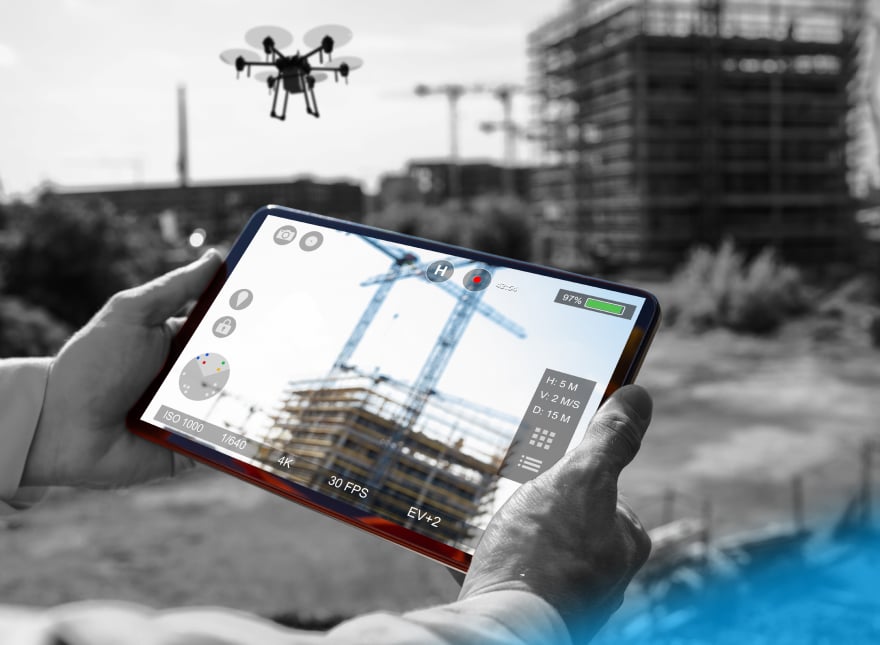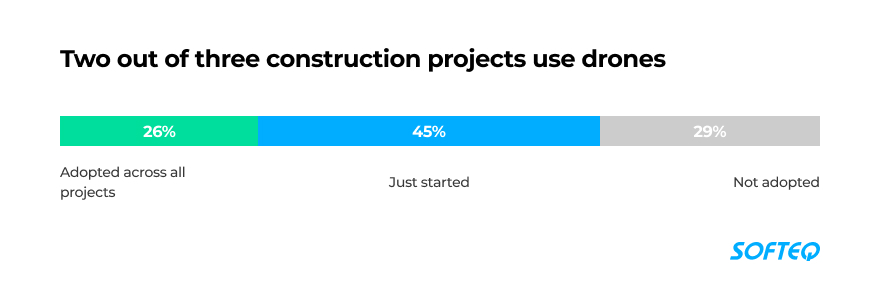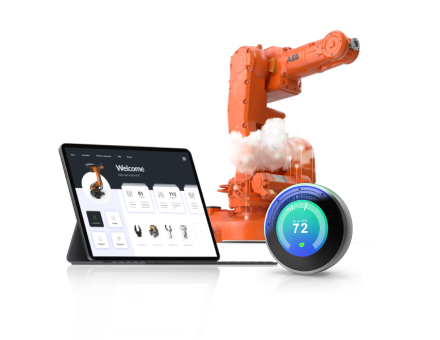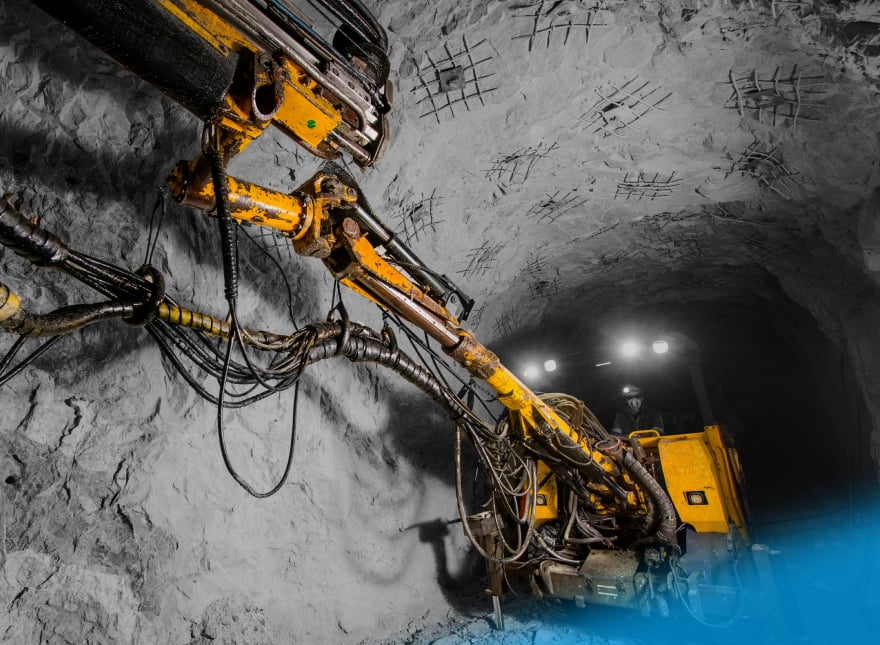Check out our latest blog article: From component to enterprise – modular robotics done right.
Prospective Uses of Drones in Construction

Construction project planning can be tough, since timelines are almost always guesswork. For this reason, and for fear of making a mistake, many foremen ask subcontractors to arrive at the construction site in advance, usually a few days early. As a result, foremen have expensive downtime, which can be a killer for smaller companies.
Planning is the perfect use case for drones. A drone can fly around a construction site in a few minutes and provide the company with detailed information about the current status of the project. This means the company can send their team and equipment when the site is ready for work, avoiding expensive downtime.
This is just one example of how drones can make operations easier for construction companies. In fact, drones are already being used on two out of three construction projects.

Let’s look at five use cases of drones in construction, their stats, and real-life examples.
Construction Drones: a Short Explanation
Drones can access hard-to-reach or unsafe places and conduct surveys over long distances. They make construction work safer and more efficient. The process works in the following way:
A drone operator designs a drone route. A drone flies over a construction site and takes images from multiple angles. Each image is tagged with coordinates. Based on these images, photogrammetry software creates 2D and 3D maps with geolocation information.
Use Case 1: Drones in Construction for Safety
Before each important step, construction crews check the site for potential hazards. For example, sometimes work is carried out at extreme heights or in dangerous environments. In addition to health risks, construction projects can result in high medical costs and legal fees.
According to DroneDeploy, drones can increase safety on a construction site by 55%, since they allow engineers to perform inspections without entering hazardous areas. Drone inspections take hours instead of weeks, which is another bonus. Ultimately, drones make inspections safer, faster, and more cost-effective.
Real-Life Example: Inspecting Industrial and Energy Construction Sites
Sundt Construction is a general contractor firm in the US whose portfolio includes energy and industrial construction projects. They often have to inspect high-pressure and high-temperature systems.
Traditional inspection methods expose engineers to scalding hot steam, as they have to spend three to four hours next to overheated structures.
To keep employees healthy, Sundt decided to use a drone solution. Now, they can obtain full photo coverage of the structure from a safe distance. Inspections have also become 10 times cheaper and eight times faster: what previously took the team four hours now takes 30 minutes.
Benefits at a Glance
- Improved safety at the construction site (2x safer, according to DroneDeploy)
- Reduced cost per inspection (10x cheaper at Sundt Construction)
- Increased inspection efficiency (8x faster at Sundt Construction)
Use Case 2: Drones in Construction for Surveying Large Distances
Survey work is an important part of almost any construction project. It enables companies to determine the project’s feasibility, provide the basis for an accurate design, and locate project features.
Construction teams traditionally take the measurements manually, then they create an aerial view or 3D model of a worksite based on the collected data. This approach means construction teams often have to travel and take detours of huge distances. Depending on the site size, data collection can take days.
Drones do an excellent job at handling this task. They take hundreds of pictures as they fly over an area of land. What humans do in hours, drones do in minutes.
Real-Life Example: Accelerating Survey Work
Bogh Engineering is a family-owned construction and engineering firm from California. Their core capability is pouring concrete. They carry out site surveying before and after every major step.
They only have one survey engineer in their team. Using traditional topographic methods, the survey engineer had to spend two days on a construction site (per survey). Then it took another day to process data and perform a cut-and-fill analysis.
To speed up the work, the company started using a drone-based solution. The drone is able to survey a site in 30 minutes. Together with data processing and analysis, the whole job now takes just half a day at each site.
Benefits at a Glance
- Fast measurement collection (4x faster at Bogh)
- Fast preparation of terrain analysis (3x faster at Bogh)
Use Case 3: Construction Drones for Surveying Hard-to-Reach Places
Projects sometimes require construction companies to gather data in a remote or hard-to-reach location. This may take too long with a traditional approach, and can push back the work’s start date.
Drones get surveying work done much faster. In some cases, using drones is the only way to accomplish the task, since they can take off and fly almost anywhere.
Real-Life Example: Surveying Inaccessible Areas
An energy firm wanted to build a solar farm at the southern tip of Illinois. They tasked Bacon Farmer Workman Engineering and Testing (BFW) with creating a 1,700-acre site-plan map.
The survey site was at the confluence of the Mississippi and Ohio rivers, with highly fertile, yet sometimes impassable swamps. It was also the wet season, and the deadline for this work was tight.
BFW tried to work using traditional methods, but they couldn’t access the area with a utility task vehicle. The crew tried to walk it, but were unable to continue after a few thousand feet.
Finally, BFW decided to use a drone for this task. As a result, they earned 40% more for the time they had allotted to do the job. They also managed to save costs for the customer—half as much compared to using traditional methods.
But that's not the only thing the company was able to offer the client. Before the survey began, the client already had ideas about where to put solar panels and equipment. The maps the drone created showed these areas would most definitely flood. The customer changed their plans so the farm would remain dry all year round, avoiding expenses caused by future damage.
Benefits at a Glance
- More profit (x1.4 profit at BFW)
- Saved costs for the client (halved costs at BFW)
- Obtained insights that saved the client’s equipment
Use Case 4: Drones for Effective Management of Construction Projects
The site constantly changes as a construction project progresses. Keeping track of these changes with traditional methods is time-consuming. By the time the data is collected, it’s already outdated. This makes project planning possible only by rough estimation.
That’s why subcontractors tend to over or underestimate the amount of time they need, often resulting in missed deadlines or inefficient resource usage.
Drones provide real-time information about every step of the construction project. Based on data, companies can optimize work plans to meet deadlines and avoid team and equipment downtime.
Real-Life Example: Avoiding Scheduling Inefficiencies
Grade Tech Services is a family-owned excavating and grading company. They have a small team and need to carefully plan where to send their people and equipment.
The company previously used ground-level progress photos and manual calculations for planning, meaning they often underestimated the amount of time needed to finish the work. At the same time, most superintendents wanted subcontractors to arrive earlier than required. This meant Grade Tech had to send their crew and equipment to the site earlier than necessary, causing downtime that cost the company about $3.5k per day.
Now, Grade Tech uses a drone to capture the condition of the site. As a result, they only send their team down when they’re sure the project is ready for them. They also use drones to measure stockpiles and cut and fill with greater accuracy than ever before. This helps them avoid exporting material offsite, which results in $10-20k savings from just one calculation.
Benefits at a Glance
- Avoided downtime ($3.5k savings each day at Grade Tech)
- Precise calculation of cut and fill ($10-20k savings from one calculation at Grade Tech)

Use Case 5: Construction Drones for Conflict Resolution
Conflicts in construction are commonplace. The more complex a project is, the more likely misunderstandings are to occur between contractors and clients. The subject of a dispute may vary from materials and extra work to past work carried out by another contractor.
By flying a drone at the start of the project, crews can document the initial site conditions. They can refer to this data in the event of a dispute and provide evidence for their position.
Real-Life Example: Avoiding Costs Due to the Fault of Another Contractor
Bogh Engineering uses drones to survey a site when they take over work from other subcontractors. Their goal is to make sure that the work is done as planned. This helps them avoid expenses that are beyond the scope of the contract.
Bogh once found an error in another subcontractor's trench work by looking at the orthomosaic view from the latest drone flight. They immediately sent the subcontractor a change order for $400 with the attached orthomosaic view from the drone as proof.
In a different project, another subcontractor’s work was off by 15,000 cubic yards. Drone data saved Bogh $160k.
Benefits at a Glance
- Avoided expensive rework caused by another subcontractor
- Prevented reputational risks
- Avoided fines
The Future of Drones in Construction: Legal Aspects
It’s likely that within a few years we will see a spike in the usage of construction drones. The size of the drone solutions market reached 6B in 2021, and is expected to double in the next seven years. The reason for this is a new legal environment that simplifies the use of construction drones.
In 2016, the Federal Aviation Administration (FAA) defined special rules for the use of commercial drones. This was an important step. Before this, anyone who wanted to use drones for commercial purposes had to apply for special permission from the FAA.
And in April 2021, the FAA took another step forward by issuing new regulations. The rules expand the use of drones in construction projects and make it easier for companies to comply with regulations for drone use on construction sites.
These legal relaxations are also likely to give more confidence to drone manufacturers. So very soon, we may see big technological advances in the construction drone industry.
More articles on the topic






